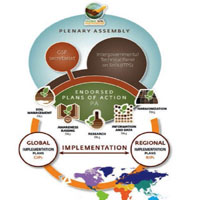Improving soil and water conservation and ecosystem services by sustainable soil management practices: From a global to an Italian soil partnership

HTML: 84
All claims expressed in this article are solely those of the authors and do not necessarily represent those of their affiliated organizations, or those of the publisher, the editors and the reviewers. Any product that may be evaluated in this article or claim that may be made by its manufacturer is not guaranteed or endorsed by the publisher.
The UN Sustainable Development Goals (SDGs) identify the need to restore degraded soils in order to improve productivity and the provision of ecosystem services. The aim is to support food production, store and supply clean water, conserve biodiversity, sequester carbon, and improve soil resilience in a context of climate change. Within this framework, in order to achieve the SDGs and to correct land management in the long-term, soil management is considered mandatory. The reduction of land degradation should be based on various sustainable soil management practices that improve and maintain soil organic matter levels, increase water infiltration, and improve soil water management. This technical review - a policy paper - summarizes the sustainable and territorial impact of soil degradation, including soil water erosion, from the global level to the European and National levels. Furthermore, with the aim of sharing ongoing soil and water management actions, instruments, and initiatives, we provide information on soil and water conservation activities and prospects in Italy.
Highlights
- Sustainable soil management practices should be implemented to address soil degradation.
- Impact of erosion on crop production reduces global crop yields by 0.4% per year.
- Improving the physical and chemical characteristics of soils can contribute to store and supply water to plants.
- Soil protection is a very important topic in the European Commission’s proposal for the CAP 2021-2027.
How to Cite
PAGEPress has chosen to apply the Creative Commons Attribution NonCommercial 4.0 International License (CC BY-NC 4.0) to all manuscripts to be published.

 https://doi.org/10.4081/ija.2020.1765
https://doi.org/10.4081/ija.2020.1765







